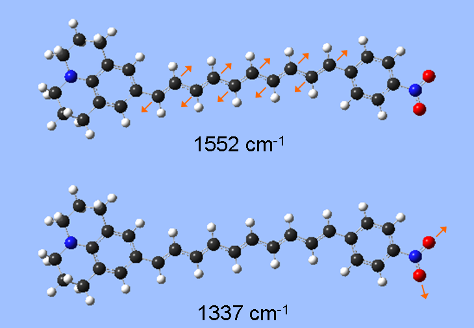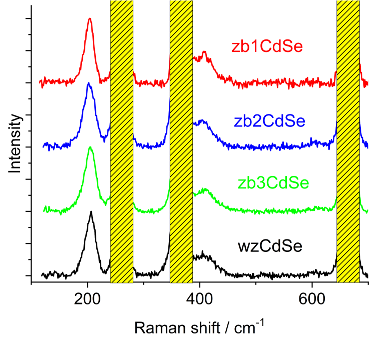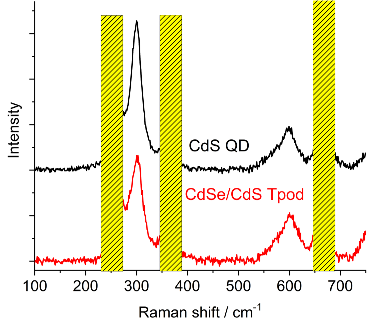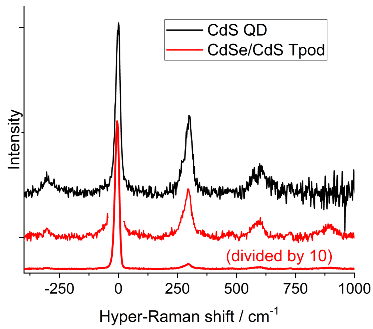|
|
|
Resonance hyper-Raman spectroscopy |
|
Hyper-Raman and hyper-Rayleigh scattering are the two-photon excited analogs of linear Raman and Rayleigh scattering. Since these processes involve two-photon excitation followed by one-photon emission, they require an intermediate state that is both one– and two-photon allowed. In centrosymmetric systems only the states of u symmetry are one-photon allowed and only states of g symmetry are two-photon allowed. Therefore within the dipole approximation hyper-Rayleigh scattering is strictly forbidden in centrosymmetric systems and hyper-Raman scattering is allowed only through vibronic coupling, and is expected to be weak. On the other hand, in “push-pull” polyenes that are simultaneously highly polar and highly polarizable, hyper-Raman scattering can be quite strong. Comparison of resonance Raman and resonance hyper-Raman spectra and excitation profiles can provide valuable information about the geometries and one– and two-photon oscillator strengths in regions of the absorption spectrum where multiple transitions overlap. |
|
Most semiconductor nanocrystals—quantum dots, nanorods, nanoplatelets—are nominally centrosymmetric in their idealized, “cartoon” forms, and should have no hyper-Rayleigh scattering and very weak hyper-Raman spectra. However, a wide variety of factors—the underlying noncentrosymmetric zincblende or wurtzite crystal structure, the faceted structure of the surface, variations in the number or type of ligands, and simply the finite number of atoms in the crystal—should render these structures at least slightly noncentrosymmetric, and the experimental observation of large dipole moments for most II-VI nanocrystals further supports this. Evidence from other spectroscopic techniques suggests that the strength of the exciton-phonon coupling in semiconductor quantum dots is largely mediated by the extent of charge asymmetry in the excitonic state. Therefore, we have set out to explore resonance hyper-Rayleigh and hyper-Raman spectra of semiconductor quantum dots as a measure of excitonic charge asymmetry. |
|
Recent publications in this field
Lian C. T. Shoute, Glenn P. Bartholomew, Guillermo C. Bazan, and Anne Myers Kelley. Resonance hyper-Raman excitation profiles of a donor-acceptor substituted distyrylbenzene: one-photon and two-photon states. J. Chem. Phys. 122, 184508 (2005).
Anne Myers Kelley, Lian C. T. Shoute, Mireille Blanchard-Desce, Glenn P. Bartholomew, and Guillermo C. Bazan. Resonance Raman, hyper-Raman, and hyper-Rayleigh depolarization ratios and symmetry breaking in solution. Mol. Phys. 104, 1239-1247 (2006).
Lian C. T. Shoute, Mireille Blanchard-Desce, and Anne Myers Kelley. Resonance hyper-Raman excitation profiles and two-photon states of a donor-acceptor substituted polyene. J. Phys. Chem. A 109, 10503-10511 (2005).
Lian C. T. Shoute, Robin Helburn, and Anne Myers Kelley. Solvent effects on the resonance Raman and hyper-Raman spectra and first hyperpolarizability of N,N-dipropyl-p-nitroaniline. J. Phys. Chem. A 111, 1251-1258 (2007).
Weinan Leng and Anne Myers Kelley. Hyper-Rayleigh and hyper-Raman scattering with intermediate and two-photon resonances. J. Chem. Phys. 127, 164509 (2007).
Weinan Leng and Anne Myers Kelley. Resonance hyper-Raman spectra of zinc phthalocyanine. J. Phys. Chem. A 112, 5925-5929 (2008).
Anne Myers Kelley. Resonance Raman and resonance hyper-Raman intensities: Structure and dynamics of molecular excited states in solution. J. Phys. Chem. A 112, 11975-11991 (2008) (invited Centennial edition).
Weinan Leng, Guillermo C. Bazan, and Anne Myers Kelley. Solvent effects on resonance Raman and hyper-Raman scattering for a centrosymmetric distyrylbenzene and relationship to two-photon absorption. J. Chem. Phys. 130, 044501 (2009).
Anne Myers Kelley. Hyper-Raman scattering by molecular vibrations. Ann. Rev. Phys. Chem. 61, 41-61 (2010).
Rui Tan, David F. Kelley, and Anne Myers Kelley. Resonance hyper-Raman scattering from CdSe and CdS nanocrystals. J. Phys. Chem. C 123, 16400-16405 (2019). |



|
CdSe quantum dots with different crystal structures and synthesized by different methods show nearly identical resonance Raman and resonance hyper-Raman/Rayleigh spectra. However, CdSe/CdS tetrapods show much stronger hyper-Rayleigh scattering than CdS quantum dots. While it is tempting to ascribe this difference to the noncentrosymmetric structure of the tetrapods, other factors may be at play including contributions from the electric quadrupole term in the radiation-matter interaction for these very large tetrapods. Work in this area is continuing. |



